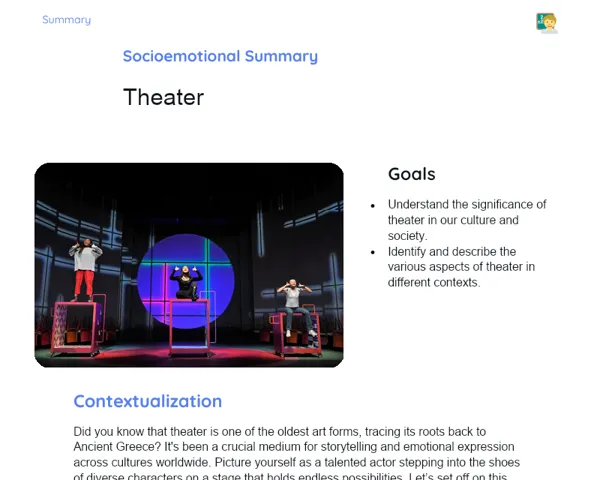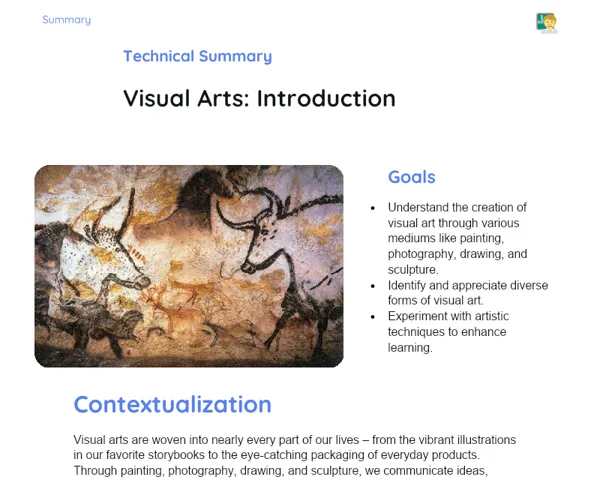Summary Tradisional | Space in the Construction of Dance Movements
Contextualization
In the realm of dance, space is a core element that significantly impacts how movements are executed. It is typically categorized into personal space, which is the immediate area surrounding a dancer, and general space, encompassing the broader environment available for movement. Grasping and utilizing these spaces effectively can elevate a performance, making it more expressive and captivating. Delving into the nuances of space enables dancers to craft varied and dynamic movements, thus enriching choreography and captivating the audience.
Moreover, orientation in space involves using directions (like forward, backward, sideways) and levels (high, medium, low) during performances. These aspects are crucial in creating rich and intricate choreography. Dancers must also be mindful of their body's planes and axes, which are essential for the precise coordination of movements. Engaging with both space and fellow dancers fosters creativity, teamwork, and body awareness—important traits both in dance and in our daily lives.
To Remember!
Personal and General Space
Personal space refers to the area directly surrounding the dancer's body. It’s the space each individual occupies where they can perform refined, contained movements. This area is vital for intricate actions such as hand gestures and facial expressions that don’t require much movement. Mastering personal space is key to the accuracy and expressiveness of these movements.
General space, on the other hand, encompasses the entire environment available for dance—be it a stage, a dance studio, or any other location. Movements that exploit general space are typically broader, incorporating larger actions like running or jumping. Skillfully using general space can inject dynamism into the performance, making it more engaging for the audience.
By distinguishing personal and general space, dancers can plan and perform choreography that fully utilizes the available environment, which is particularly important during group performances. This awareness helps prevent collisions and creates a visually appealing spectacle.
-
Personal space: the immediate area surrounding the dancer, used for fine and contained movements.
-
General space: the entire environment available for dance, used for larger movements and actions.
-
Understanding and skillfully using these spaces enhances choreography and performance.
Directions and Levels
In dance, directions refer to the ways a dancer can orient their body while executing movements. Basic directions include forward, backward, sideways, and diagonally. Utilizing various directions in choreography contributes to creating patterns, keeping the audience interested by adding complexity and visual appeal to the performance. Movements across different directions also facilitate better exploration of the available space.
Levels concerning dance refer to the height at which movements are performed. There are three primary levels: high, medium, and low. High-level movements include jumps or lifts, medium-level movements are executed in a standing position, and low-level movements occur close to the ground, such as squats or rolls. Mixing different levels enriches the performance, adding variation and dynamism to choreography.
It's fundamental for any dancer to understand and effectively use directions and levels, which contributes to creating more intricate and visually captivating performances and aids in coordination and spatial planning, especially in group choreography. Varying directions and levels also amplifies expressiveness and emotional communication through dance.
-
Directions: movements oriented forward, backward, sideways, and diagonally.
-
Levels: movement heights classified as high, medium, and low.
-
Integrating directions and levels enhances the performance and adds complexity.
Planes and Axes
Planes in dance refer to the imaginary surfaces that divide the space into different orientations. The main planes include horizontal, vertical, and sagittal. The horizontal plane is parallel to the ground and includes movements such as turns and rolls. The vertical plane is perpendicular to the ground, encompassing movements that go up and down, such as jumps. The sagittal plane divides the body into right and left segments, including forward and backward movements. Recognizing these planes empowers dancers to execute coordinated and precise movements.
The axes of the body are imaginary lines around which movements manifest. There are three primary axes: longitudinal, transverse, and sagittal. The longitudinal axis runs vertically from top to bottom and is utilized in rotational movements. The transverse axis runs horizontally from side to side, used in elevation and lowering actions. The sagittal axis runs from front to back and incorporates flexion and extension movements. A solid understanding of these axes facilitates greater control and coordination in movements.
Combining planes and axes in dance allows for crafting three-dimensional and complex movements, adding depth and multimedia appeal to the performance while helping dancers exploit the full potential of the available space. Familiarity with these concepts is crucial for executing harmonious choreography.
-
Planes: horizontal, vertical, and sagittal.
-
Axes: longitudinal, transverse, and sagittal.
-
Comprehending planes and axes enables coordinated and three-dimensional movements.
Dimensions of Movement
The dimensions of movement in dance refer to different characteristics that can be adjusted to create variations in movement styles. Amplitude is one of these dimensions, signifying the size of a movement. Larger amplitude movements occupy more space and are broader, while smaller amplitude movements are more compact. Altering amplitude can shift the perception of a movement, either adding expressiveness or intricacy.
Direction is another important dimension of movement that can be single or multiple. Single-direction movements are more straightforward and focused, while multiple-direction movements offer complexity and dynamism. Changing the direction of movements during a performance can captivate the audience and add depth to the choreography.
Speed represents the third dimension of movement and can be categorized as fast or slow. Quick movements communicate energy and intensity, while slower movements possess a softer, more expressive quality. Modulating the speed of movements during a dance has the potential to incorporate contrasts, introducing both drama and lightness. Mastering these dimensions of movement is essential for any dancer, granting them the ability to create richer and more engaging choreography.
-
Amplitude: the size of the movement, whether large or small.
-
Direction: can be single or multiple.
-
Speed: can be fast or slow, contributing to contrast and expressiveness.
Interaction with Space and Peers
Interaction with space in dance emphasizes the creative and conscious use of the dancer's surrounding environment. This entails moving within the available general space, avoiding collisions, and optimizing the area to craft dynamic choreography. Engaging with space allows dancers to explore different areas of the stage or room, injecting variation and visual flair into the performance.
Equally significant is the interaction with peers, especially in group performances. This entails coordinated communication among dancers, ensuring synchronization and harmony in movements. Interactions may involve mirrored movements, where dancers mirror each other's actions, or complementary movements, where one dancer's actions respond to the other's.
Team cooperation and engagement during dance nurture creativity and enhance group cohesion, resulting in more unified and visually striking performances. Moreover, these skills in interaction and coordination are valuable not just in dance but across various activities requiring teamwork and collaboration.
-
Interaction with space: strategic and creative utilization of the surrounding environment.
-
Interaction with peers: mutual coordination and communication for synchronizing harmonious movements.
-
Teamwork in dance enhances creativity and group unity.
Key Terms
-
Personal space: immediate area around the dancer's body.
-
General space: the environment available for dance.
-
Directions: movement orientations (forward, backward, sideways, diagonally).
-
Levels: heights of movements (high, medium, low).
-
Planes: imaginary surfaces dividing space (horizontal, vertical, sagittal).
-
Axes: imaginary lines around which movements occur (longitudinal, transverse, sagittal).
-
Amplitude: size of movement (large or small).
-
Speed: rate of movement (fast or slow).
-
Interaction with space: leveraging the surrounding environment.
-
Interaction with peers: collaborative coordination among dancers.
Important Conclusions
In this session, we've delved into the significance of space in shaping dance movements, differentiating between personal space and general space and how each can be harnessed to enhance a performance. We've also examined how the use of directions and levels can lead to more intricate choreography, alongside understanding planes and axes of the body to refine coordination and precision in movements.
We explored the dimensions of movement, including amplitude, direction, and speed, and how these factors can be manipulated to infuse expressiveness and vigour into a dance. The significance of interaction with space and with peers was underscored as a vital component of constructing cohesive and harmonious choreographies that promote collaboration and creativity.
Mastering these concepts is crucial for any dancer, as it enables a more expressive and coordinated performance. Additionally, these skills are beneficial beyond the dance floor, fostering better body awareness and cooperation skills in everyday contexts.
Study Tips
-
Revisit the concepts of personal and general space, directions and levels, planes and axes, and dimensions of movement, making detailed notes on each.
-
Practice various dance movements in front of a mirror, focusing on how you navigate space, directions, and levels.
-
Watch professional dance performances and take note of how they utilize space and engage with each other. Try to recreate some of the movements and patterns you observe.


